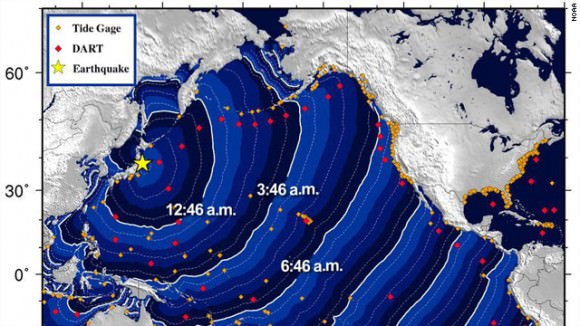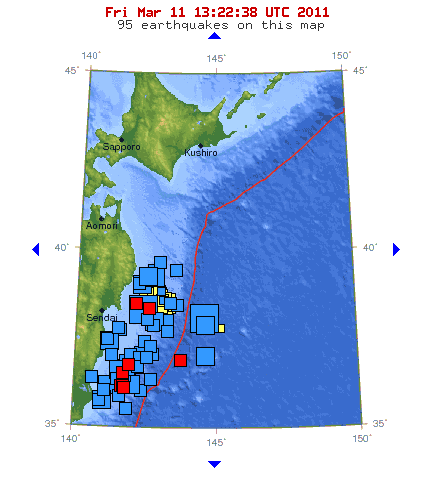[/caption]
An 8.9-magnitude earthquake struck off the coast of northern Japan on March 11, one of the strongest to ever hit Japan. The massive quake has triggered tsunamis not only in Japan, but around the Pacific Basin. Walls of water and debris have inundated coastal areas of Japan, and tsunami warnings were issued for at least 20 countries and numerous Pacific islands, including coastal Russia, the western coast of Canada and the US, the Marcus Islands, Taiwan, Guam and the Hawaiian Islands, where a full coastal evactuation has been taking place throughout early Friday morning. Strong aftershocks, as strong as 6.5-magnitude continue to shake the region, (the latest U.S. Geological Survey map, above, shows 95 recent quakes in the area) and at least one nuclear power plant in Japan may be encountering problems. Images coming from Japan show widespread damage from both the quakes and the tsunamis.
The USGS reported that the epicenter of the earthquake was 373 kilometers (231 miles) northeast of Tokyo and 130 km (80 miles) east of Sendai, Honshu. Police reports from Sendai say that so 200-300 bodies have been recovered, but the total death toll will likely be much, much higher. Reports say this is the 6th largest earthquake ever monitored, and the largest in Japan in over 140 years.
Tokyo did not suffer much damage, but in northern Japan, many areas were devastated. Compounding the damage was a wall of water that rushed inland of the island nation, leveling houses and washing away boats, cars and other debris. Click here to see some shocking images from the New York Times.
Reports says Japan is evacuating thousands of people from nearby a nuclear power plant, but the current condition of the reactor core is unknown at this time. Four reactors are located near the Earthquake area. The reactors were shut down, and no leaks have been found so far, but the cooling system for the reactors may not be working correctly.
Reports via Twitter say the roof may have collapsed at JAXA Tsukuba Space Center.
Tsunami waves have now begun to wash ashore in the Hawaiian Islands. The first waves are not necessarily the strongest; waves are predicted to be 2-3 meters (6-8 ft.) in Hawaii. Tsunamis are very hard to predict, and the USGS says wave heights can vary widely.
Get the latest on the tsunami predictions from NOAA’s Pacific Tsunami Warning Center.
See this Google Map, overlaid with NOAA-predicted tsunami times.
Callan Bentley at the AGU Blogosphere has a good overview of earthquake and tsunami dynamics.



Watch Video Of Japan’s 8.9 Tsunami Earthquake
http://japan-earthquake.notlong.com
The events of the day are pretty tragic. The earthquake off Sendai Japan
was Richter 8.9, which makes is a borderline super-quake. A superquake is
generally Richter 9.0 or above. Super-quakes are where the longitudinal
waves are so severe that non-bedrock land can flow like water. This quake
was a pretty serious bitch.
Of course the big killer is the Tsunami, which is something most people do
not understand. Water waves are rather complicated, and the differential
equations which describe them are call Bousenesq equations. A tsunami is
not a transverse wave. It is a pressure wave with a longitudinal mode. It
also travels very fast at about 700km/hr. What happens is that this travels
as a pressure wave in the open ocean, but when it reaches a continental
shelf the wave is reflected partially upwards. This has the effect of
converting it into a transverse wave as water moving along is now pushed
upwards. This is a very nonlinear process and nontrivial to model. This
pushing up of the water does cause water at the shore to initially recede
outwards, quicly followed by the wve front that sweeps in. The energy of
the fast moving pressure wave is converted into a towering transverse wave
front which moves more slowly.
Now there is a problem with the Fukushima nuclear power plant having a
cooling system malfunction. I must confess I think it is the height of
stupidity to build a nuclear power planet near a major fault zone.
Lawrence B. Crowell
I reckon it is quite stupid to build a nuclear power plant anywhere on Planet Earth – too any unpredictables, including first and formost human folly.
The only use for nuclear power plants I advocate is electricity for space craft propulsion, way “out there”, where accidents don’t affect us.
Well, we must have energy, preferably it should be AGW neutral, and the whole of Japan is a major fault zone. That is presumably why Fukushima is a light water plant, loosing its cool doesn’t mean it will go nuclear.
Now these big daddies happen once every year, so it will be decades before another one breaks a Japanese power plant. With luck we may have started to phase them out because fusion was useful (not so optimistic on that one, mind) and cheaper.
The alternative is carbon plants, which AFAIU kills thousand of people with massive emissions of dust and radioactivity (!) every year and will have us enter an AGW climate regime for better or for worse.
D’oh! *Coal* plants, slip of the mind there.
Yes but what is the alternative? The Size of Japan is very limited.
We need to develop a more accurate system that can predict earthquake and tsunami like disasters much before their taking place. This will save a lot of innocent lives.
http://musclexedgesite.com/